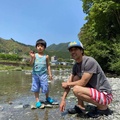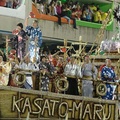Happy New Year! What makes this holiday so special is the chance to start over again. But before looking forward, it’s nice to take a quick look back.
I thought about how I spent New Year’s in the past. As a kid, I would be allowed to stay up late and our family would watch the countdown to midnight on television. I don’t recall doing anything more special than that.
Then, when I was 14, our family moved to Japan. My father was a soldier in the U.S. Army and was assigned to a military base outside of Tokyo. I should add that my father, who is third-generation Nikkei, met my mother when he was stationed in Okinawa, Japan. So I guess that makes me three-and-a-half generation Nikkei of California and Okinawa descent!
For our first New Year in Japan, we went to the home of my mother’s cousin. It wasn’t a traditional Japanese home. It was in a planned community built as a bedroom town about an hour outside of Tokyo. The place is called Tama New Town and the funny thing that I remember is that the Hello Kitty theme park, called Sanrio Puroland, is located there.
So back to New Year’s. Our families got together and we watched TV again, but this time instead of Dick Clark in New York City, we watched a celebrity singing competition on NHK that pits the men (the white team) against the women (the red team). The show is called Kohaku Uta Gassen and it was once the most popular show on Japanese TV. Only the most popular entertainers are chosen to perform and for young talent, an appearance on Kohaku meant that your star is on the rise. I understand that today, people can vote by cell phone to decide which team wins.
We also ate traditional food called “osechi-ryori” that was served inside special stacked boxes. Inside those boxes were “konbu” (boiled kelp), “kinpira gobo” (burdock root), “kamaboko” (fish cakes), “kuromame” (sweetened black beans) and other delicacies. I was brave enough to try everything.
Another year, my dad took me to the Meiji Shrine located next to Harajuku Station in Tokyo. It was packed with so many people making their way inside the shrine to ring a bell and offer their prayers (and loose change) to the Shinto gods. This practice is called “Hatsumode.” I also picked up a daruma doll for making a wish for the New Year and a wooden arrow, but no one ever explained the significance of the arrow.
There was another time on New Year’s Day when we joined a Japanese Boy Scout troop to make mochi by pounding steamed sweet rice with large wooden mallets. This tradition is called “mochi-tsuki.” The mallet is heavy so it takes some effort to pound the rice until it gets the right amount of stickiness. “Mochi-tsuki” also involves teamwork as two or three people can pound together in unison with another person who bravely reaches into the bowl to flip the mochi. The best part though, is getting to eat the mochi and there was always plenty left over to take home.
So I’m grown up now and living back in the U.S.A. New Year’s now is back to watching the ball drop on television and the next day watching a lot of college football. While I might not practice Japanese traditions, at least I have plenty of good memories of celebrating the culture of my roots with my family.
© 2008 Bobby Okinaka





